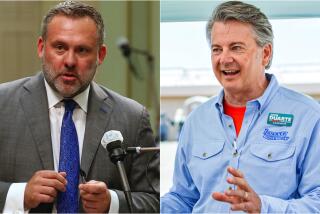24th District Campaign Could End Up Very Costly
- Share via
WASHINGTON — If federal elections records are any indication, this year’s race to fill Rep. Anthony C. Beilenson’s seat in Congress could turn out to be one of the most expensive in the nation.
Brad Sherman, a Democrat who is seeking to represent the 24th Congressional District--which stretches from Thousand Oaks to Sherman Oaks and Malibu--ranked among the nation’s top campaign self-financers by infusing $275,000 into his coffers.
In comparison, he raised just over $12,000 from other contributors, according to year-end election reports.
Rich Sybert, the leading GOP candidate for Beilenson’s post, had lent significant sums from his savings two years ago in his unsuccessful attempt to unseat Beilenson (D-Woodland Hills), who is retiring.
This time, however, Sybert’s campaign will rely less on his personal accounts.
“At this point, with fund raising going as well as it is, it does not look like it’s going to be necessary” to tap into personal funds, said Sybert’s campaign manager, John Thees.
Sybert raised $112,000 last year, some of it going to help retire debts from the 1994 campaign, which hover around $500,000. Sybert’s latest reports do not list any additional infusion of personal money.
Sherman, a member of the State Board of Equalization and an accountant and attorney, said he financed his race for the tax board in 1990 by cashing out all his real estate investments and lending the money to his campaign. After he won, he was paid back most of the money in subsequent years.
Sherman is confident that the same process will occur with his bid for the congressional seat held by Beilenson. And he is prepared to kick in even more money should he reach the general election.
“Before I ask anyone to help me accomplish a project, I should do everything I can--and I have,” Sherman said. “It shows my supporters that I am not only serious, but committed.”
*
Although he is spending freely from his own pocketbook, Sherman said he supports limits on self-financing.
“I think it is impossible for the average middle-class person with no substantial wealth to run for a high office,” he said. “On the other hand, you take a look at city council races and it’s possible.”
Foreshadowing campaign spending sprees that could reach into the millions of dollars, two San Fernando Valley congressional candidates are also relying heavily on their personal cash, federal elections records show.
Doug Kahn, a Democrat who is seeking the seat occupied by retiring Rep. Carlos J. Moorhead (R-Glendale), has spent $400,000 on his campaign, more than any other challenger in the United States, according to reports filed with the Federal Elections Commission.
Kahn, a wealthy businessman from Altadena, lent his campaign a total of $700,000 in 1995, records show, but he returned $300,000 of the funds to himself after deciding that he did not need to spend so much so early.
Kahn bankrolled unsuccessful campaigns against Moorhead in 1992 and 1994, losing 50% to 39% in his first try and 53% to 42% two years later. With Moorhead stepping aside after more than two decades in office, Kahn sees this year’s 27th Congressional District race as a golden opportunity--and he is laying out more money than ever, according to his aides.
But he must first get past Democratic challenger Barry Gordon in next month’s primary. Gordon raised $77,500 last year, of which just $1,250 came from personal funds.
Gordon is former president of the Screen Actors Guild and has extensive contacts in the entertainment industry that could lead to more cash. Actors Kevin Costner and Ed Begley Jr. have already written $500 checks to Gordon’s campaign fund.
Gordon suggested that Kahn is spending so much money to make up for deficiencies in his campaign.
“It takes money to run a campaign, but it takes more than money to win an election,” Gordon said. “It takes a message and a track record.”
*
Whoever wins the Democratic nomination to replace Moorhead will face Assembly Majority Leader James Rogan (R-Glendale) in November. The former judge reported $65,104 in contributions at the end of 1995, records show, with none of the funds coming from the candidate himself. But his contacts among conservative groups will probably boost his war chest significantly as the general election nears.
Other California candidates who dipped heavily into their own savings, according to a listing compiled by Roll Call newspaper, were psychiatrist Irwin Savodnik, a Republican who is spending $386,700 of personal money is his race against Rep. Jane Harman (D-Rolling Hills), and Michela Alioto, who put up $100,000 of her own funds in her challenge of Rep. Frank Riggs (R-Ukiah).
Alioto, a 27-year-old former aide to Vice President Al Gore, is the youngest of those bankrolling their own campaigns. She was paralyzed from the waist down in 1981 when a ski lift collapsed in Lake Tahoe and is using part of her settlement money to fund her campaign.
“Michela is not extraordinarily wealthy,” spokesman Tom Pier said. “Putting up this much money shows a personal commitment on her part and, if you get money in the bank early, it raises your viability and helps get your message out.”
While election laws limit contributors from giving more than $1,000 to any one candidate, candidates themselves can pour as much as they want into their own bids.
In all, 11 House challengers across the country spent $100,000 or more from their own bank accounts in 1995, federal election records show. There were 81 candidates who contributed at least $10,000 to their congressional bids, according to FEC documents.
More to Read
Get the L.A. Times Politics newsletter
Deeply reported insights into legislation, politics and policy from Sacramento, Washington and beyond. In your inbox twice per week.
You may occasionally receive promotional content from the Los Angeles Times.







